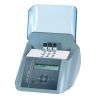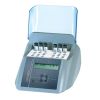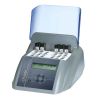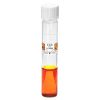YSI 910 COD Colorimeter
Features
- Automatic data storage; 16 data-sets with date and time stamp
- User-calibration to any government or organizational standard (N.I.S.T. or ISO)
- IP68 waterproof case; easy to hold or set on benchtop; floats
- Free ground shipping
- Expedited repair and warranty service
- Lifetime technical support
- More
Overview
The YSI 910 COD colorimeter is a rugged, waterproof, single-parameter instrument for the measurement of COD (chemical oxygen demand). The EPA-approved COD test is useful for performing rapid, frequent monitoring of treatment plant efficiency, and results allow quick response to changing conditions in the waste stream while the traditional BOD5 test takes 5 days to determine results.
Mechanics
The instrument features a large, backlit display, a real-time clock, automatic data logging as well as the ability to export data to a PC or printer using the 900 Series Data Hub for infrared data transfer.
Benefits
- Automatic data storage; 16 data sets with date and time stamp
- Large, backlit LCD display
- IP68 waterproof case; easy to hold or set on benchtops and floats
- Innovative light shield prevents moving parts or separate pieces that can easily be broken or lost
- User calibration to any government or organizational standard (for example N.I.S.T. or ISO)
- Resolution can be improved for specific range requirements
- Known interferences can be adjusted for the sample
- Auto shutoff extends battery life
- Power Supply: 4 alkaline AAA batteries; approximately 17 continuous hours or 5,000 tests
- Auto Shutoff: 20 minutes after last key press; audible signal
- Operating Range: 5° to 40°C (41° to 104°F); 30-90% relative humidity
- Display: Backlit LCD
- Memory Capacity: 16 data sets with date and time stamp; automatic
- Weight: 260 g (0.5 lbs)
- Dimensions: 15.9 L x 7.6 W x 3.8 H cm (6.1 L x 3 W x 1.5 H in)
- Interfaces: Infrared interface with the 900 Series Data Hub (optional) for data transfer
- Operation: Acid/solvent resistant case; touch-sensitive keypad with audible feedback; factory calibrated; user calibration possible; reset to factory cal
- Certifications: CE; IP68 waterproof rating (1 hour at 0.1 meter); floats
- Colorimetric Resolution: 0.01 A (absorbance)
- Photometric Accuracy: 3% FS (T = 20° to 25°C) (68° to 77°F)
- Wavelength Accuracy: ±1 nm
- Warranty: 1 year
- Optics: LEDs, 2 interference filters (IF) and photo sensor in a transparent chamber. Interference filters are range dependent.
- Wavelength Range: 430 nm IF Δ λ = 5 nm for range 0 to 150 mg/L; 610 nm IF Δ λ = 5 nm for ranges 0 to 1,500 mg/L and 0 to 15,000 mg/L
- (1) 910 COD colorimeter
- (1) Hard-sided carrying case
In The News
USGS report reveals rising chloride concentrations in northern U.S. streams
When the air turns frigid and roadways across the U.S. grow slick with ice, many communities sow their streets with salt to improve driving conditions. Eventually, however, snow and ice melt, washing all that salt into the water supply. A new U.S. Geological Survey report shows that concentrations of chloride, a chemical component of sodium chloride (salt), exceed toxic levels in 84 percent of the northern U.S. streams tested. Published recently in Science of the Total Environment, the report follows up on a 2010 USGS study on stream chloride levels. The new report builds upon the 2010 study by examining trends in chloride concentrations over time, and is based on data from USGS, U.S. Environmental Protection Agency and Milwaukee Metropolitan Sewerage databases.
Read MoreStudy backs building nitrate-filtering wetlands in farming landscapes
It turns out that combating nutrient runoff from agricultural lands might be as simple as knowing where to add a little water. A new study led by Indiana University scientists suggests that introducing wetlands could help act as a buffer against harmful nutrient runoff from excessive fertilizer use. The study is one of the first of its kind documenting how farmland conversion to natural habitats might help improve water quality. Led by Christopher Craft, a Janet Duey professor in Rural Land Policy at IU Bloomington’s School of Public and Environmental Affairs, a team of a half dozen researchers began their research in 2008 after receiving funding from the U.S. Department of Agriculture.
Read MoreUSGS groundwater survey of California deserts finds high concentrations of inorganic chemicals
A U.S. Geological Survey study of groundwater in southern California desert regions found high concentrations of naturally occurring inorganic elements in contrast with very little man-made pollutants, according to a USGS release. Arsenic, boron, fluoride, gross-alpha radioactivity, molybdenum, strontium, vanadium, and uranium were found in 35 percent of wells tested by the USGS from 2006 to 2008. The highest concentrations were found in parts of Owens Valley, Antelope Valley, the Mojave, Coachella Valley, Colorado River Basin and Indian Wells Valley. These elements are likely naturally occurring in desert rocks and soils. Groundwater absorbs the elements as it contacts them.
Read More
























